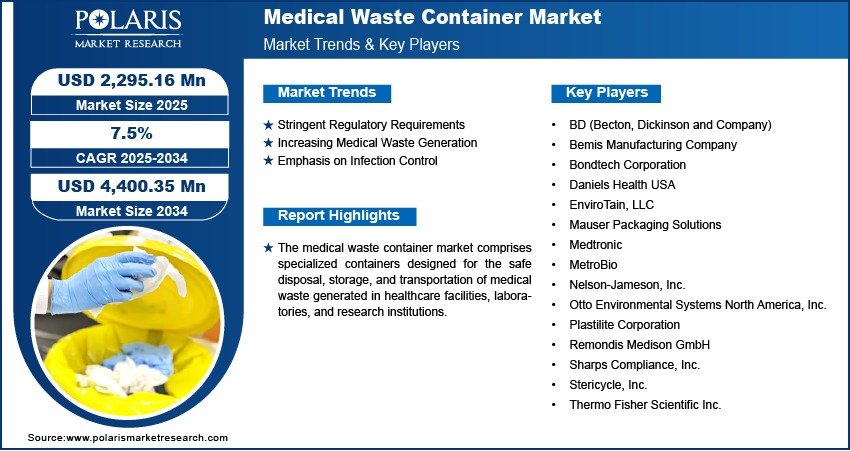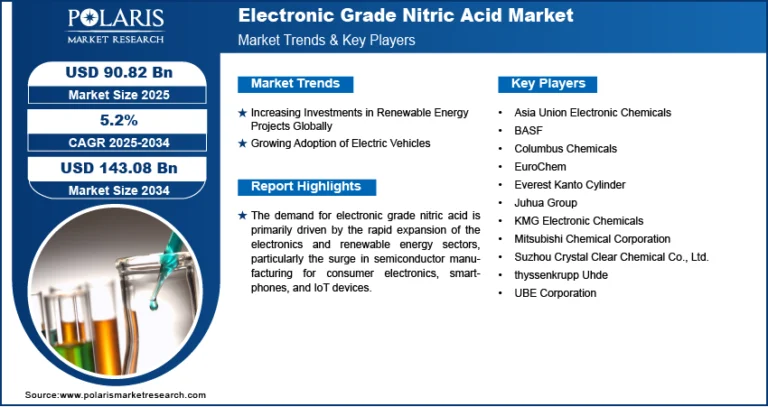Medical Waste Container Market Expected to Value USD 4,400.35 Million by 2034, with a CAGR of 7.5%

The global medical waste container market was valued at USD 2,140.01 million in 2024. The market is anticipated to grow from USD 2,295.16 million in 2025 to USD 4,400.35 million by 2034, reflecting a compound annual growth rate (CAGR) of 7.5% during the forecast period of 2025–2034. Increasing concerns about the proper disposal of biomedical waste and the enforcement of strict regulatory frameworks are major factors contributing to market expansion.
Key Market Trends:
-
Rising Healthcare Waste Volume:
The increase in surgical procedures, diagnostic activities, and hospital admissions globally has led to higher volumes of medical waste, boosting demand for reliable waste containment solutions. -
Adoption of Eco-Friendly Materials:
Manufacturers are shifting toward recyclable and biodegradable materials to align with environmental compliance and corporate sustainability goals, influencing product innovations in the market. -
Integration of Smart Technologies:
RFID-enabled and sensor-equipped medical waste containers are gaining traction as they improve tracking, compliance monitoring, and reduce manual handling risks. -
Outsourcing of Waste Management Services:
Healthcare institutions are increasingly outsourcing waste management to specialized third-party service providers, which in turn is driving the demand for standardized, compliant waste containers. -
Stringent Regulatory Norms:
Regulatory bodies such as the EPA, WHO, and OSHA are enforcing strict waste segregation and disposal standards, necessitating the use of labeled and safe containers across medical facilities.
Market Size & Forecast:
|
Market Size in 2024 |
USD 2,140.01 million |
|
Market Value in 2025 |
USD 2,295.16 million |
|
Revenue Forecast by 2034 |
USD 4,400.35 million |
|
CAGR |
7.5% from 2025 to 2034 |
Request for Free Sample:
Industry Overview:
The medical waste container market plays a vital role in ensuring hygienic waste disposal, preventing contamination, and protecting healthcare workers and patients from exposure to hazardous materials. These containers are designed for various types of waste, including sharps, pathological waste, pharmaceutical byproducts, and general biomedical refuse. The market spans a broad range of end users including hospitals, clinics, diagnostic laboratories, and research institutions. Demand is further elevated by global public health initiatives and the expansion of healthcare infrastructure, especially in emerging economies.
Key Market Drivers & Barriers:
Drivers:
-
Increased Global Healthcare Expenditure: The rising healthcare spending in both developed and developing nations is enabling hospitals to invest in improved waste management systems, driving container adoption.
-
Focus on Infection Control: Growing concerns about hospital-acquired infections and cross-contamination are compelling institutions to follow proper medical waste handling protocols.
-
Urbanization and Aging Population: As urban areas expand and the elderly population increases, more medical services are required, leading to higher waste generation.
Barriers:
-
High Costs of Compliant Containers: FDA and EPA-compliant containers come with higher costs, which may limit adoption among smaller healthcare centers or those in low-income regions.
-
Lack of Awareness in Developing Nations: Insufficient training and knowledge about regulated medical waste disposal can hinder market growth in certain parts of Asia and Africa.
Market Opportunity:
The Medical Waste Container Market holds significant potential for innovation, particularly in smart container systems, customizable modular units, and biodegradable materials. Furthermore, countries with expanding healthcare access and infrastructure modernization programs, such as India, Brazil, and Indonesia, present lucrative opportunities for manufacturers. Strategic partnerships between container producers and healthcare facilities or waste disposal firms are also expected to foster growth in the coming years.





